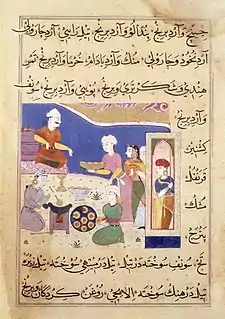The Ni'matnāmah Naṣir al-Dīn Shāhī (Naskh: نعمتنامه ناصیرالدینشاهی; Persian: نعمت نامه نصیرالدین شاهی, lit. 'Naṣir al-Dīn Shāh's Book of Delicacies', is a medieval Indian cookbook, written in Persian language in Naskh script, of delicacies and recipes, some accompanied by paintings illustrating the preparation of the dishes.[1] It was started for Ghiyath Shah (r. 1469–1500), the ruler of the Malwa Sultanate in central India. After he was forced to abdicate, it was completed for his son 'Abd al-Muzaffar Naṣir Shāh. (r. 1500–10).
Manuscript history
After the fall of Mandu to the Mughals, the manuscript eventually found its way to the Bijapur Collection in the 1600s, as shown by a seal of Muḥammad 'Adil Shāh on the flyleaf.[2] From there it passed to Tipu Sultan and then to the library of the India Office. It is now in the India Office collections in the British Library, London.[3]

Art historical analysis
The Ni'matnāmah was first published from the art historical point of view in 1959 by Robert Skelton (1929–2022), a life-long curator at the Victoria and Albert Museum.[4] Skelton noted that some illustrations have women painted wearing men's various types of Persian and Indian garments and turbans, including a specific style of turban which is also featured in Turkman style paintings of 1470s. The style of the surrounding landscape are influenced by the Turkmen style of the last third of the 15th century. Art historians have also noted that at least two artists collaborated in illustrating the Ni'matnāmah.[5] These artists emphasized different features of Turkmen style of Shirazi painting that was contemporary at that time. The illustrations also introduced representations of indigenous costumes of Malwa and Indian facial types. Such stylistic innovations are also seen in paintings from the Cāurāpāñcāśikā series. This suggests that reciprocal influences were at work between centers of painting of Muslim and Hindu patronage.[5]
References
- ↑ Carl Hermann Ethé, Catalogue of Persian Manuscripts in the Library of the India Office (London, 1903). no. 149, catalogue no. 2775.
- ↑ Identification and illustrations in https://blogs.bl.uk/asian-and-african/2016/11/nasir-shahs-book-of-delights.html
- ↑ Norah M. Titley (2005). The Niʻmatnāma Manuscript of the Sultans of Mandu : the Sultan’s Book of Delights. RoutledgeCurzon; Ursula Sims-Williams (2021). "Collections Within Collections: An Analysis of Tipu Sultan’s Library," Iran 59, no. 2, 287-307, DOI: 10.1080/05786967.2021.1911760. Further details and illustrations in https://blogs.bl.uk/asian-and-african/2016/11/nasir-shahs-book-of-delights.html
- ↑ Skelton, Robert (1959). "The Ni'mat nama: A Landmark in Malwa Painting". Marg. xi (3): 44–48.
- 1 2 M Bloom, Jonathan (2009). The Grove Encyclopedia of Islamic Art and Architecture Vol 1. Oxford: Oxford University Press. p. 236. ISBN 978-0-19-530991-1.